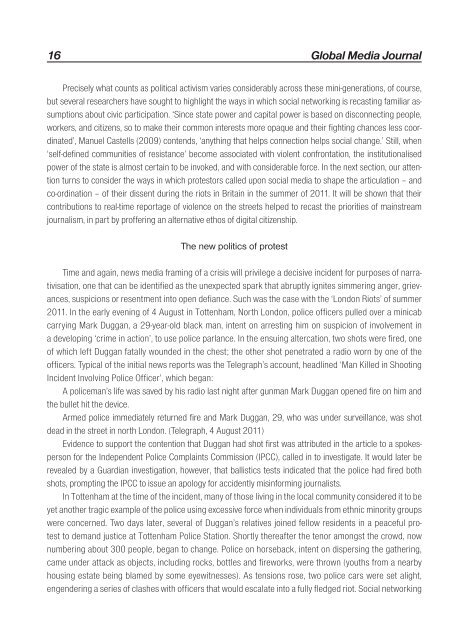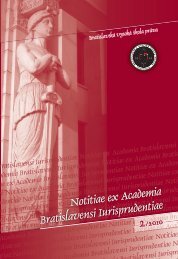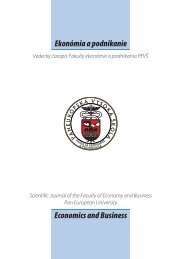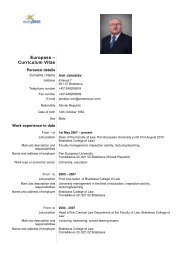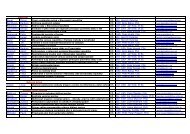ÄÃslo 1/2013 - Paneurópska vysoká Å¡kola
ÄÃslo 1/2013 - Paneurópska vysoká Å¡kola
ÄÃslo 1/2013 - Paneurópska vysoká Å¡kola
You also want an ePaper? Increase the reach of your titles
YUMPU automatically turns print PDFs into web optimized ePapers that Google loves.
16<br />
Global Media Journal<br />
Precisely what counts as political activism varies considerably across these mini-generations, of course,<br />
but several researchers have sought to highlight the ways in which social networking is recasting familiar assumptions<br />
about civic participation. ‘Since state power and capital power is based on disconnecting people,<br />
workers, and citizens, so to make their common interests more opaque and their fighting chances less coordinated’,<br />
Manuel Castells (2009) contends, ‘anything that helps connection helps social change.’ Still, when<br />
‘self-defined communities of resistance’ become associated with violent confrontation, the institutionalised<br />
power of the state is almost certain to be invoked, and with considerable force. In the next section, our attention<br />
turns to consider the ways in which protestors called upon social media to shape the articulation – and<br />
co-ordination – of their dissent during the riots in Britain in the summer of 2011. It will be shown that their<br />
contributions to real-time reportage of violence on the streets helped to recast the priorities of mainstream<br />
journalism, in part by proffering an alternative ethos of digital citizenship.<br />
The new politics of protest<br />
Time and again, news media framing of a crisis will privilege a decisive incident for purposes of narrativisation,<br />
one that can be identified as the unexpected spark that abruptly ignites simmering anger, grievances,<br />
suspicions or resentment into open defiance. Such was the case with the ‘London Riots’ of summer<br />
2011. In the early evening of 4 August in Tottenham, North London, police officers pulled over a minicab<br />
carrying Mark Duggan, a 29-year-old black man, intent on arresting him on suspicion of involvement in<br />
a developing ‘crime in action’, to use police parlance. In the ensuing altercation, two shots were fired, one<br />
of which left Duggan fatally wounded in the chest; the other shot penetrated a radio worn by one of the<br />
officers. Typical of the initial news reports was the Telegraph’s account, headlined ‘Man Killed in Shooting<br />
Incident Involving Police Officer’, which began:<br />
A policeman’s life was saved by his radio last night after gunman Mark Duggan opened fire on him and<br />
the bullet hit the device.<br />
Armed police immediately returned fire and Mark Duggan, 29, who was under surveillance, was shot<br />
dead in the street in north London. (Telegraph, 4 August 2011)<br />
Evidence to support the contention that Duggan had shot first was attributed in the article to a spokesperson<br />
for the Independent Police Complaints Commission (IPCC), called in to investigate. It would later be<br />
revealed by a Guardian investigation, however, that ballistics tests indicated that the police had fired both<br />
shots, prompting the IPCC to issue an apology for accidently misinforming journalists.<br />
In Tottenham at the time of the incident, many of those living in the local community considered it to be<br />
yet another tragic example of the police using excessive force when individuals from ethnic minority groups<br />
were concerned. Two days later, several of Duggan’s relatives joined fellow residents in a peaceful protest<br />
to demand justice at Tottenham Police Station. Shortly thereafter the tenor amongst the crowd, now<br />
numbering about 300 people, began to change. Police on horseback, intent on dispersing the gathering,<br />
came under attack as objects, including rocks, bottles and fireworks, were thrown (youths from a nearby<br />
housing estate being blamed by some eyewitnesses). As tensions rose, two police cars were set alight,<br />
engendering a series of clashes with officers that would escalate into a fully fledged riot. Social networking<br />
GMJ Book.indb 16 21.1.<strong>2013</strong> 9:44


